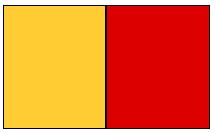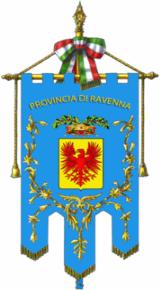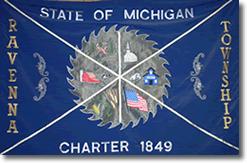
JOURNAL OF GREAT WATERS ASSOCIATION OF
VEXILLOLOGY
December 2009
Vol. XIV, No. 2, Issue 28

The Flags of the Ravennas: Italy, Ohio, and Michigan
by Kevin Harrington, M.A.(T), FFIAV
There are several Ravennas in
North America, generally small towns, except for the city of Ravenna in Ohio and
the township of Ravenna in Michigan. It seems that each of these places bears
the name of the first Ravenna, a city in Emily-Romagna region of northern Italy.
The name, which has nothing to do with ravens, is ancient and of indeterminate
meaning. The Etruscan form was Ravna or Navna but not enough is known about the
Etruscan tongue -- perhaps it wasn’t even an Indo-European language -- which
disappeared when Etruria (today’s Tuscany) was taken over by the Romans. Some
claim the suffix na or enna is Etruscan for ‘place’. However a
book published by De Agostini Editore, Nomi d’Italia, claims that a
pre-Latin term rava meaning ‘ravine’ or the ‘torrent’ that pours through
a deeply eroded valley.
Arms and Flag of the
City of Ravenna
I have
 visited this startlingly
Byzantine city and seen its cathedral, churches, museums, mosaics, walls, and
icons. It was the capital of the Western Roman Empire and as a Byzantine exarchy controlled insular and southernmost Italy as well as a strip of land
from Ravenna to Rome. Ravenna’s importance declined after the 8th century. The
shield of the city’s coat of arms, the colours of which form the basis for the
city flag, is blazoned ‘per pale or and gules, a fruited and rooted pine tree
vert (green), superimposed at the partition, touched by two counter-rampant
lions, gold and red.’ The pine tree in Italy signifies benignancy and
cordiality, an old and generous nobility, and a philosophical bent as the pine
grows readily anywhere. The tree also recalls the vast pine forests of the
region now reduced to protected coastal groves. The lions may be Venetian in
origin as Venice controlled the area when heraldry was developing. Roberto Breschi, the noted Italian vexillologist, suggests the arms date from 1469.
visited this startlingly
Byzantine city and seen its cathedral, churches, museums, mosaics, walls, and
icons. It was the capital of the Western Roman Empire and as a Byzantine exarchy controlled insular and southernmost Italy as well as a strip of land
from Ravenna to Rome. Ravenna’s importance declined after the 8th century. The
shield of the city’s coat of arms, the colours of which form the basis for the
city flag, is blazoned ‘per pale or and gules, a fruited and rooted pine tree
vert (green), superimposed at the partition, touched by two counter-rampant
lions, gold and red.’ The pine tree in Italy signifies benignancy and
cordiality, an old and generous nobility, and a philosophical bent as the pine
grows readily anywhere. The tree also recalls the vast pine forests of the
region now reduced to protected coastal groves. The lions may be Venetian in
origin as Venice controlled the area when heraldry was developing. Roberto Breschi, the noted Italian vexillologist, suggests the arms date from 1469.

Ravenna’s civic flag is a simple rectangular cloth divided into two
equal vertical panels of yellow (or gold) and red (gules). Roberto Breschi
doubts they can be traceable directly to the Byzantine imperial colours of
that faraway time. Rather they are related to the colours of local lords such
as the Da Polenta family who ruled the area in the 13th and 14th centuries.
Arms and Flag of the
province of Ravenna

Ravenna is the capital of the
province of the same name. The arms of this province, adopted in 1938, are
also red and gold - ‘or, an eagle displayed gules’. Ravenna
province once used a red over blue gonfalone, a hanging banner much
adopted throughout Italy as a
form of civic flag, bearing the coat of arms, wreaths of oak and olive, and a
coronet. A more recent statute on provincial symbols says,
‘An
ornate cloth of light blue (azure) richly embroidered in gold, charged in the
centre with the province’s coat of arms with the inscription Provincia di
Ravenna in gold letters.’ The ornateness refers to intertwined curlicues
flanking the arms and extending into the tails of the gonfalon. The eagle has
probably been taken from the eagle device, the earlier one-headed version, of
the Holy Roman Empire by the lords of Ravenna, the aforementioned Da Polenta.
Ravenna, Ohio
The Ohio town of Ravenna in
Portage County, was first settled by a man named Tappan. His name was proposed for the settlement but he countered with Ravenna, his fiancée’s favorite choice,
after the Italian city, although Tappan had never visited Italy. The field for the flag is dark
blue. On a white circle appears the letter R for the town’s name. Flanking it is
a red flower with green leaves and stem, hoistward, and a green plant (a
shamrock?) with roots. Below the letter R is a tool or instrument resembling a
‘T’ on its side. John Purcell says this is a gavel, alluding to the town’s role
as county seat (FOTW, 2008). The five-pointed white star suggests the location
of the town in north-eastern Ohio. The year of settlement in red appears below
the circle, 1799. Although utterly lacking in foundation, the flower and roots
are said to allude to the meaning of the city name, as mentioned in Larry L.
Miller’s Ohio Place Names (Indiana UP, 1996). The city flag of Ravenna was
adopted by Ordinance 1972-62, passed August 21, 1972. (The flag was designed by
school children participating in a contest run by the Ravenna Junior Chamber of
Commerce. –Ed.)
for the settlement but he countered with Ravenna, his fiancée’s favorite choice,
after the Italian city, although Tappan had never visited Italy. The field for the flag is dark
blue. On a white circle appears the letter R for the town’s name. Flanking it is
a red flower with green leaves and stem, hoistward, and a green plant (a
shamrock?) with roots. Below the letter R is a tool or instrument resembling a
‘T’ on its side. John Purcell says this is a gavel, alluding to the town’s role
as county seat (FOTW, 2008). The five-pointed white star suggests the location
of the town in north-eastern Ohio. The year of settlement in red appears below
the circle, 1799. Although utterly lacking in foundation, the flower and roots
are said to allude to the meaning of the city name, as mentioned in Larry L.
Miller’s Ohio Place Names (Indiana UP, 1996). The city flag of Ravenna was
adopted by Ordinance 1972-62, passed August 21, 1972. (The flag was designed by
school children participating in a contest run by the Ravenna Junior Chamber of
Commerce. –Ed.)
Ravenna Township,
Michigan
This writer views the flag as
extremely ‘busy’ and the elements could be simplified through stylization. It is
just trying to say too much and some of the devices used
 could be applied to Anytown, USA. Basically on a medium blue field there is a saw-blade (silver)
divided into six sections by a thin white line forming a saltire across the
whole flag and another vertical line through the blade’s centre. Very small and
therefore hard- to-identify devices include a church, a blue schoolhouse with a
bulldog (town mascot), a red barn with cow, a U.S. flag (proper colours),
sheaves of wheat and corn, and a deer (for wildlife) -- all framed by too many
words and curlicues. The well-chosen saw blade is the most significant device as
it reflects the area’s lumber industry which peaked in 1887. The intersecting
lines likely refer to the township’s central position in southern Michigan, a
cross-roads; unfortunately they create an ‘x ‘ with negative connotations. There
are at least eight colours on the flag and the excessive wording would result
in a flag rather expensive to produce. When a meeting of local townships was
organized, likely in the1980s, the group leaders suggested each township bring
along its flag. Ravenna didn’t have one; so a flag was designed and stitched by
a Home Economics teacher, Mrs. Christopher, and accepted by the township. There
is just one flag, stitched only one side, and it is held very dear by the
township officials. It is not flown but mounted on the wall of the office.
(Information courtesy of Sonja, a township employee of over 21 years.)
could be applied to Anytown, USA. Basically on a medium blue field there is a saw-blade (silver)
divided into six sections by a thin white line forming a saltire across the
whole flag and another vertical line through the blade’s centre. Very small and
therefore hard- to-identify devices include a church, a blue schoolhouse with a
bulldog (town mascot), a red barn with cow, a U.S. flag (proper colours),
sheaves of wheat and corn, and a deer (for wildlife) -- all framed by too many
words and curlicues. The well-chosen saw blade is the most significant device as
it reflects the area’s lumber industry which peaked in 1887. The intersecting
lines likely refer to the township’s central position in southern Michigan, a
cross-roads; unfortunately they create an ‘x ‘ with negative connotations. There
are at least eight colours on the flag and the excessive wording would result
in a flag rather expensive to produce. When a meeting of local townships was
organized, likely in the1980s, the group leaders suggested each township bring
along its flag. Ravenna didn’t have one; so a flag was designed and stitched by
a Home Economics teacher, Mrs. Christopher, and accepted by the township. There
is just one flag, stitched only one side, and it is held very dear by the
township officials. It is not flown but mounted on the wall of the office.
(Information courtesy of Sonja, a township employee of over 21 years.)Other Ravennas
There are other Ravennas in
Kentucky and Nebraska, as well as Ravenna Township, Minnesota; however, none has
a flag. There was no reply from Ravenna, Texas, to a flag inquiry. Ravennas
once existed in Ontario and California, but have become parts of neighboring
communities. ©
